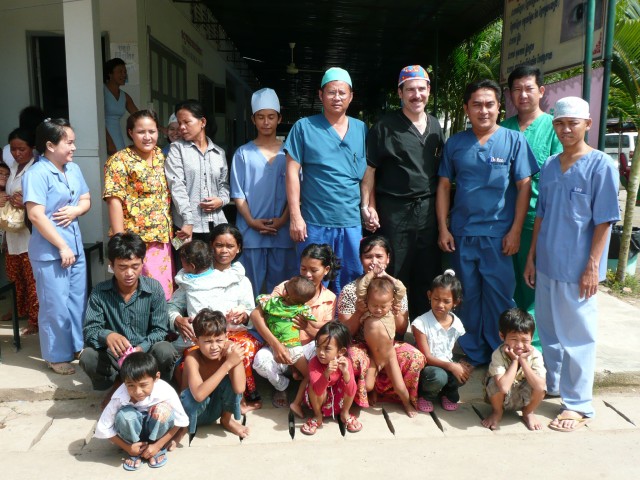For half his life, a 13-year-old boy from central Cambodia, suffered from pain, swelling, and deafness on the left side. "We heard the American team was helping people so we came to the hospital to see if we could get help. No one has been able to treat our son," his mother said. Maj. Jon Robitschek, chief resident on the Sight, Sound, and Smiles Mission, recognized the patient had a life threatening collection of infected fluid near his brain. "When we operated we found about a cup of pus, massively eroded bone, and a cholesteatoma which had destroyed most of his hearing," said Robitschek. "Without the operation this boy would have developed meningitis or a lethal abscess in his brain within a short time." As part of a humanitarian outreach program, Tripler Army Medical Center sent specialized surgical teams to three Southeast Asia countries this year. Tripler Army Medical Center is the Department of Defense\'s tertiary referral medical center for Asia and the Pacific. The missions were part of the Pacific Command's (PACOM) mission to strengthen relationships and set conditions for regional security and prosperity. In many parts of developing Southeast Asia, health care access and capabilities are limited or too expensive, preventing impoverished families from getting the care they need. As a result, there is large demand for all types of medical services but in particular specialized care. Recognizing the need for specialty care, and the significant impact that disorders of vision, hearing loss, craniofacial abnormalities, and other conditions of the head and neck can have, a specialized team that could treat those disorders was assembled. The missions were named Sight, Sound, and Smiles because they were designed to provide surgical treatment for vision loss, hearing loss, and craniofacial disorders (cleft lip and palate). Many of these disorders can be treated definitively with surgery. Col. Thomas Crabtree, medical director of the Center of Excellence in Disaster Management and Humanitarian Assistance, said the missions are part of the Peace through Health Care initiative, a congressional program designed to provide humanitarian assistance, improve medical readiness of US surgical staff, and increase the medical capacity of our host country colleagues. Three surgical missions took place this year. Tripler physcians planned, coordinated and led the teams: Lt. Col. Scott Roofe led the team to Kuantan, Malaysia; Lt. Col. Christopher Klem and Lt. Col. Benjamin Cable led the team to Bogra, Bangladesh, and Lt. Col. Joseph Sniezek and Lt. Col. Mitchell Ramsey led the team to Phnom Penh, Cambodia. All three missions had similar goals -- to provide free surgical care to impoverished civilians, provide training and education, and build health care capacity. The Tripler teams collaborated with host nation military and civilian medical personnel. Two missions were carried out at military hospitals and one at a charity hospital. The team size ranged from 7-13 personnel depending upon the host country's needs and capabilities. The team composition included otolaryngology head and neck surgeons, ophthalmologists, surgical technicians, and nurses. Some teams had additional personnel depending on the host country's need and capacity-building focus. Ramsey, the mission team leader for Cambodia, indicated that most of the patients treated by the team would not have been able to get the care they needed because of lack of available expertise, cost, or other limitations in the health care system. "Most of the patients we saw had chronic, serious, life threatening conditions, such as infections or tumors, and we were able to treat them once and for all," Ramsey said. "Being able to fix someone with a serious problem is extremely gratifying, but even more exciting is the training and exchange which increases the local surgeon's capacity to manage these problems over the long term," he said. Sniezek, chief of the otolaryngology service, said the teams were able to treat several types of disorders. "Our teams had an amazing range of capabilities and we were able to treat most disorders of the head and neck, to include vision loss from cataracts, hearing loss from chronic infections, cleft lips and palate, and thyroid tumors," Sniezek elaborated. Most of the procedures resulted in definitive treatment, meaning that the original problem was repaired, eliminated or otherwise cured. More than 350 patients were evaluated and more than 150 surgical procedures were performed on the three missions. "Regardless of how you look at the outcomes: return on investment, training experience, capacity building, good will, or most importantly, the life altering impact on the patients, these missions were an incredible success," Ramsey said.
Tripler Army Medical Center Ear, Nose, Throat Docs
By Tripler Army Medical center Public Affairs OfficeOctober 9, 2008




Social Sharing